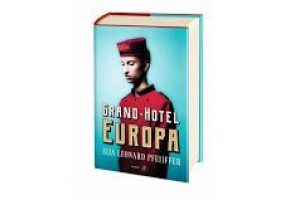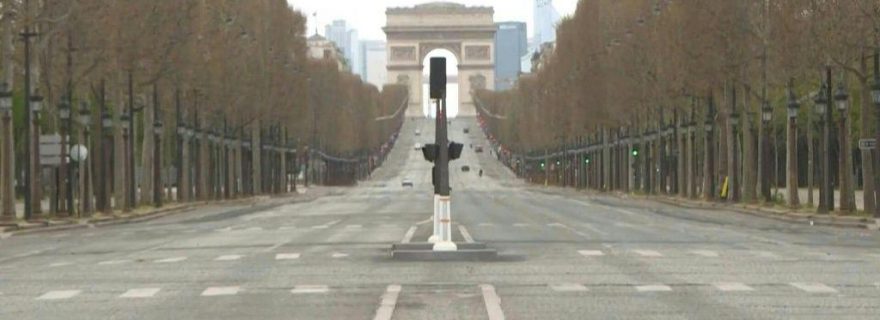Redefining Europe’s Identity During Corona
During the Covid-19 crisis, almost all public life has come to a standstill for the past two months and the cultural sector seems to be hit the hardest financially. But what is the impact of the current crisis on Europe’s cultural life from a Humanities perspective?
In the past weeks, the whole cultural sector had to close its doors because of the current corona crisis: theatre performances were cancelled, museums could no longer be visited, concert halls could not invite people for an evening of music, the world-famous outdoors flower exhibition de Keukenhof could not continue this year, and most ironically, the exhibition Besmet! (Contaminated!) in Rijksmuseum Boerhaave had to be postponed.
The Netherlands under lockdown. NOS op 3 / YouTube.At the same time, almost all intercontinental flights from and to Europe are cancelled until further notice. Cruise ships do not moor in the harbour of Venice for the time being, which has the interesting side effect that fish can be spotted in Venice’s Canal Grande and dolphins show up in Italian harbours curious why the waters are so silent. The streets of Paris are empty and Rome, the eternal city, has never been so deserted before.
With museums being closed and tourists staying away, the financial impact of the crisis on the cultural sector is mentioned time and again: while the airline combination Air France-KLM is being saved by the French and Dutch governments, parts of the Dutch cultural sector are going bankrupt. When cultural minister Ingrid van Engelshoven told on the national tv that she had to fight to receive 300 million euros to support the cultural sector, the minister’s financial promise was initially variably received by the cultural sector in the Netherlands. We could very well evaluate whether the amount is enough or whether the financial support acknowledges how important culture is in Dutch society such as Dutch presenter Cornald Maas was questioning in the talk show M, but that passes over the more essential question what the current crisis can tell us about the importance of culture in the Netherlands and in Europe more generally.
Europe: The Continent of Nostalgia
We must not forget that in the past the Dutch government always responded by closing down the cultural sector during an impending crisis. The best example of this custom is the International Theatre Amsterdam, which was often closed during war in the seventeenth and eighteenth centuries, first because church officials argued that the public morals should be uplifted, later Amsterdam’s city government closed the theatre on its own initiative: no fun during a crisis. In those days, there existed no subsidies or any form of financial support for culture, but the city’s public theatre always survived albeit sometimes under new management.
Luckily, this is not the case today. The importance of culture has also changed drastically: Europe's culture has become an export product for the rest of the world to see and enjoy. Therefore, it seems even more contradictory that the Netherlands and Europe at large have already been in a lockdown for the past two months, while summer is upon us. Normally, these months are the busiest season for the tourist branch. Not this year, however. The fact that both Spain and Italy are mainly focussing on domestic tourism shows that there is currently a different approach to Europe’s sense of identity, which is arguably rooted in its rich history, architecture, fine art, and catering industry.

To explore this further, it might be fruitful to turn to the Dutch bestseller Grand Hotel Europa (2018) by Ilja Leonard Pfeijffer. In this novel, Pfeijffer’s alter ego gives a critique of Europe in the twenty-first century. What is Europe? And what connects Europeans? Over dinner with his table companion Patelski, Pfeijffer formulates five points that characterize Europe following George Steiner’s idea of Europe. These are:
- Europe has an abundance of cafes;
- Europe has domesticated its nature;
- Europe is saturated by its own history;
- Europe is a product of an awkward engagement of reason and religion;
- Europe is aware of its own decline.
The abundance of cafes throughout Europe is obviously a product of the Enlightenment, when cafes and salons were still the breeding grounds of discussion and debate, but Pfeijffer also mentions how those cafes contribute today to the appeal of Europe as a touristic destination. The second characteristic is interesting in the sense that Pfeijffer argues that Europeans have always treated their nature as a garden, a hortus conclusus, whereas in the Americas, in Asia, in Oceania, and in Africa nature can be a fierce opponent. Europe’s nature is easily accessible to the public for consumption. The third trait of Europe’s identity is its rich history. Pfeijffer writes:
The fourth characteristic entails that Europe is a product of Christianity, which combines the Greek tradition of reasoning and the adoption of a monotheistic religion in an awkward, often contradictory union. It has brought forward great thinkers who used reason to explain faith, who used reason to build monuments for faith, and eventually used reason to challenge faith during the Enlightenment. Those accomplishments are, however, in the past and Europe is painfully aware of this: we have neither the power nor the money to force the rest of the world to listen to us. The only thing we can sell is our history. We administer our own decline, while tourists gape at our monuments and consume our culture. In other words, Pfeijffer says that Europe exists today primarily as the world’s museum or the world’s largest amusement park. And the cafes which were initially established to change the world are now one of the key ingredients of the ‘real’ European experience.
And tourists keep coming, because they want to see Leonardo Da Vinci's Mona Lisa in real life, although on reproductions you can see it better. But that is beside the point. Pfeijffer says: ‘the point is that you want to see the Mona Lisa in real life because of the experience of seeing her in real life’ (transl. of Pfeijffer 2018, 113). This is what Walter Benjamin has called the aura of an original work of art, which my colleague Liselore Tissen will discuss in a next blog post with regards to the current corona crisis.
Does it matter then that your view is obstructed by other tourists and that you have to move again within one minute? Apparently not. Mass tourism destroys that which it attracts, says Pfeijffer.
The End of Mass Tourism?
However, Pfeijffer’s analysis of Europe applied to Europe in times of financial progress and when people could easily move around. The current crisis challenges what Pfeijffer concludes about Europe and mass tourism. What is Europe if its existence as a cultural power house cannot be justified in the world because of the current crisis? What if the millions of Americans and Chinese stay away after the corona crisis? A pessimistic conclusion would be that without the tourists to visit Europe’s world heritage sites, to behold the Mona Lisa in real life, or to simply drink coffee in one of its many cafes, Europe becomes a hollow shell, stripped of all meaning, without the aura of an original art work. Europe turns form the world’s museum or amusement park into the world’s most dusty archive never to be looked at again. The news that many of the streets of Europe’s capitals are not wide enough to ensure social distancing, does not help our situation.
Yet, the current crisis could perhaps also create new opportunities for Europe, since the effects of tourism are not positive alone. Venice has become a ghost town in the past decades with more hotels than there are Venetians living in the island city. In Amsterdam, locals are ridden over by tourists wanting the ‘real’ Dutch experience by renting bicycles. While the tourists are contained in their own countries, Europe could rethink what it wants with its tourism industry. The question is not only how we can make our streets corona proof for the renewed flows of tourists in the future, but also how to simultaneously improve the life standards of Europeans living in those wonderful and ancient cities without their lives being too much disrupted by tourism. The authentic experience that every tourist craves when visiting Europe could be reinvented by reorganizing Europe's tourist industry. In the end, the appeal of Europe is not that we have beautiful architecture, fine art, and nice cafes, but that there are Europeans living the real European experience.
Further Reading
About the history of the International Theatre Amsterdam, see:
- Amber Oomen-Delhaye, De Amsterdamse Schouwburg als politiek strijdtoneel. Theater, opinievorming, en de (r)evolutie van Romeinse helden (1780-1801) (Hilversum: Verloren, 2019).
- J.A. Worp, Geschiedenis van den Amsterdamschen Schouwburg 1496-1772. Uitgegeven met aanvulling tot 1872 door J.F.M. Sterck (Amsterdam 1920).
For my discussion of tourism, aura, and authenticity, see:
- Ilja Leonard Pfeijffer, Grand Hotel Europa (Amsterdam: De Arbeiderspers, 2018).
© Tim Vergeer and Leiden Arts in Society Blog, 2020. Unauthorised use and/or duplication of this material without express and written permission from this site’s author and/or owner is strictly prohibited. Excerpts and links may be used, provided that full and clear credit is given to Tim Vergeer and Leiden Arts in Society Blog with appropriate and specific direction to the original content.



0 Comments